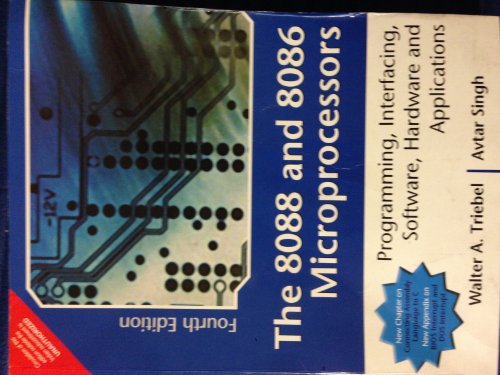Designers of microprocessor-based electronic equipment need a systems-level understanding of the 80x86 microcomputer. This volume offers thorough, balanced, and practical coverage of both software and hardware topics. Develops basic concepts using the 8088 and 8086 microprocessors, but the 32-bit version of the 80x86 family is also discussed. Examines how to assemble, run, and debug programs, and how to build, test, and troubleshoot interface circuits. Provides detailed coverage of floating-point processing and the single instruction multiple data (DIMD) processing capability of the advanced Pentium processor. Includes added material on number systems, logic functions and operations, conversion between number systems, and addition/subtraction of binary numbers. Includes new advanced material such as floating Point Architecture and Instructions, Multimedia (MMX) Architecture and Instructions, and the hardware and hardware architecture of the Pentium 3 and Pentium 4 processors. Covers the Intel architecture microprocessor families: 8088, 8086, 80286, 80386, 80486, and the latest Pentium® processors. Illustrates commands of the DEBUG program and how to assemble, disassemble, load, save, execute, and debug programs on the IBM PC. Introduces the contents of the 8088's instruction set. Explores practical implementation techniques, covering the use of latches, transceivers, buffers, and programmable logic devices in the memory and I/O interfaces of the microcomputer system. A valuable handbook for self-study in learning microprocessors, for electrical engineers, electronic technicians, and all computer programmers.
Intel's 80x86 family of microprocessors is the most widely used architecture in modern microcomputer systems. This widely acclaimed edition provides comprehensive coverage of both the software and hardware of the 8088 and 8086 microprocessors. New material has been added on number system conversions, binary arithmetic, and combinational logic operations.
- Part I explores the software architecture and how to write, execute, and debug assembly language programs. It includes many practical concepts and software applications. In addition, the various steps of the assembly language program development cycle are explored.
- Part II examines the hardware architecture of microcomputers built with the 8088 and 8086 microprocessors. It presents the function and operation of each of the microprocessors' hardware interfaces: memory, input/output, and interrupt. The role of each of these subsystems is explored in relation to overall microcomputer system operation.
- Part III provides detailed coverage of the other microprocessors in the 80x86 family: the 80286, 80386, 80486, and Pentium' processors. The newest Pentium® family—Pentium® III and Pentium® IV#&151;are also examined.
